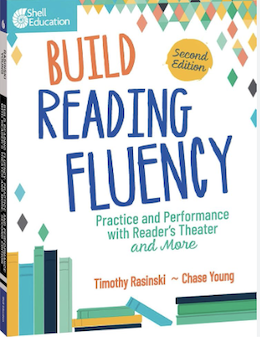Build Reading Fluency: Practice and Performance with Reader’s Theater and More
By Timothy Rasinski and Chase Young
(Shell Education Publishing, 2024 – Learn more)
Reviewed by Claire Stein
 “To be, or not to be, that is the question.” ~ W. Shakespeare
“To be, or not to be, that is the question.” ~ W. Shakespeare
When it comes to Reader’s Theater, there is no question it should be – be a part of your curriculum, that is. In Building Reading Fluency, Rasinski and Young argue that Reader’s Theater builds skills, comprehension and a true love of reading.
As a classroom teacher, I was reintroduced to reader’s theater and used this strategy with my students. In a full-circle moment, a grandmother who volunteered to read aloud to my students turned out to be a reader’s theater actor that I remembered seeing perform as a child. She was larger than life in her performances – no costumes or props needed!
 That is Reader’s Theater at its core, a way to show a plot and character’s emotions and draw in the audience and performer alike, all through intonation, cadence, expression, pacing, etc. That being said, I was a novice teacher at the time, and I don’t think I realized or appreciated all of the skills my students were gaining by participating in Reader’s Theater.
That is Reader’s Theater at its core, a way to show a plot and character’s emotions and draw in the audience and performer alike, all through intonation, cadence, expression, pacing, etc. That being said, I was a novice teacher at the time, and I don’t think I realized or appreciated all of the skills my students were gaining by participating in Reader’s Theater.
I have to admit when I started reading Build Reading Fluency, I felt overwhelmed at the heavy focus on academic skills and was eager to reach the part where they started cutting stories for scripts and how to achieve the wonder I felt when I had watched performances.
But soon the authors shifted my focus and brought into perspective the whole purpose of their research, writing, and ultimately the use of this mode of teaching: fluency.
Achieving fluency through the joy of reading
Reader’s Theater is not “fluff,” as the authors point out. Reading for pleasure and practicing techniques that focus on the joy that reading promote fluency; these are not separate ideas or competing practices.
Build Reading Fluency is a great resource to connect the ideas of reading instruction, assessment and joy. The authors are backed by not only their own observations and research but also a myriad of other research highlighting the effectiveness of this teaching method.
Teaching reading cannot only be the “science” of the practice; it must also embody the passion in the discipline. Allowing students to explore poetry, song, performance, etc. as ways to learn fluency, expression and other literacy skills is a way to foster not only a love of reading but also to meet our fluency goals.
The authors set up the book in a very thoughtful way. They introduce the research, offer their definition of reading fluency, and then provide various frameworks for using Reader’s Theater in the classroom.
Once all this background information is established, the authors provide real examples that demonstrate the ways in which reader’s theater can manifest in the classroom. They also break down the ways in which reader’s theater can be successful or not. They highlight some important aspects of this strategy, like coaching and performance.
The power of Points to Ponder
Each chapter focuses on a point of reading fluency and connects those ideas to reader’s theater and its use as a teaching strategy. One aspect of each chapter that is particularly useful is ending each section with Points to Ponder. These are a few questions that prompt the reader to reflect upon the section, their own reading journey, and their own teaching practices.
These provide a quick review of the section and a reminder to connect what has been learned and to consider how Reader’s Theater can be added to our toolbox as an effective way to provide reading instruction, particularly around fluency skills. This is a valuable resource within the book that can be referred back to quickly to remember the big ideas and make connections to our work.
At any point in our teaching careers, at any level, in any discipline, we are reading teachers. Using Reader’s Theater to teach songs, poetry, subject specific vocabulary, etc. is one way to increase student engagement, joy, understanding, and fluency in your classroom. After all, “All the world’s a stage, and all the men and women merely players.” ~ W. Shakespeare
Claire Stein is a former middle school teacher in Southern Wisconsin. She currently works in an administrative role in her school district. Claire is passionate about creating joyful learning spaces for all students and seeking out strategies to utilize in her own work and share with colleagues and other educators.


